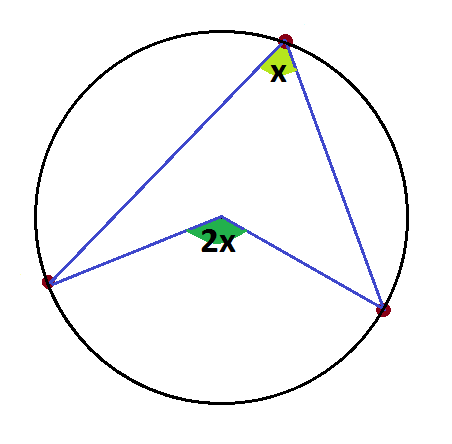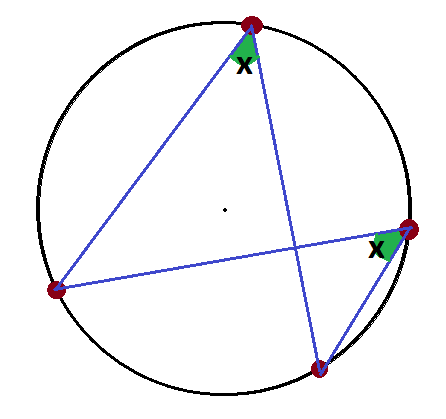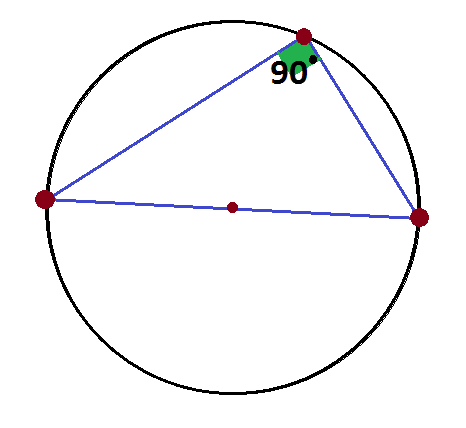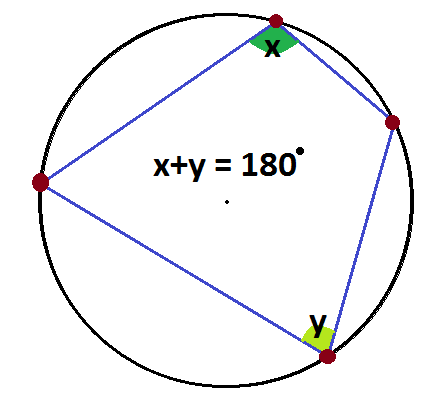
Applications of Circle Geometry
We have looked at some different rules for finding angles and lengths in circles. In this chapter, we are going to recap those rules and look at how to combine them to find values.
Angles in Circles
- Angle at the centre theorem: the angle at the centre is twice the size of the inscribed angle.
- Angles subtended by the same arc theorem: when there are two fixed endpoints, the angle is always the same, no matter where it is on the circumference.
- Angle in a semicircle: The angle inscribed in a right angle is always a right angle ($90^\circ$90°).
- Angles in cyclic quadrilaterals: The opposite angles in a cyclic quadrilateral add up to $180^\circ$180°.
Here are the geometrical proofs above written the way you will find them when you have to select them doing your exercises:

Angles at a centre theorem: angle at the centre of a circle is twice the angle at its circumference.

Angles subtended by the same arc theorem: angles at the circumference standing on the same arc are equal.

Angle is a semicircle: the angle in a semicircle is a right angle.

Angles in cyclic quadrilateral: opposite angles in a cyclic quadrilateral are supplementary.
Distances in Circles
We can use all our existing mathematical knowledge, including the properties of triangles and quadrilaterals, Pythagoras' theorem, as well as congruency proofs to solve problems involving circles and angles.
Here are some additional facts:
- The radii in a circle are always equal.
- To calculate a chord length: $\text{Chord length }=2r\sin\left(\frac{c}{2}\right)$Chord length =2rsin(c2)
where $r$r is the radius of the circle $c$c is the angle subtended at the centre by the chord or $\text{Chord length }=\sqrt{r^2-d^2}$Chord length =√r2−d2, where $r$r is the radius of the circle and $d$d is the perpendicular distance from the chord to the centre of the circle.
- The perpendicular line from the centre of a circle to a chord bisects that chord.
Here are the Mathspace geometrical reasonings you may need when calculating distances in circles, exactly as you will find them in the exercises:
- Radii of a circle are equal.
- Any point on the perpendicular bisector of a segment is equidistant from the edge points of that segment.
- The perpendicular from a centre of a circle to a chord bisects the chord.
- The line from the centre of a circle to the midpoint of a chord is perpendicular to the chord.
- The perpendicular bisector of a chord of a circle passes through the centre of the circle.
- Chords of equal length are equidistant from the centre.
- Chords of equal length subtend equal angles at the centre.
- A tangent to a circle is perpendicular to the radius drawn to the point of contact.
- The two tangents drawn to a circle from a external point are equal in length.
Let's use this info to find some missing values.
Worked Examples
Question 1
Calculate $x$x and give reasons for your answer.

Question 2
In the diagram, $\angle BAC=45^\circ$∠BAC=45°. Calculate $x$x and give reasons for your answer.

Question 3
Calculate the angle marked $x$x at the centre of the circle. Give reasons for your answer related to the properties of a circle.
